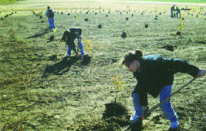      |
| |
| |
|
|
| |
|
| |
|
| |
|
| Construction
& siting issues |
|
|

|
The decision
to use phytoremediation at a site is not an easy one. Many factors
must be taken into consideration, including the intended level
of human contact, the time necessary to complete the remediation
process, and the depth and extent of contamination. To assist
in making this decision, the Phytotechnologies work team has
developed a “decision tree” that is available at
www.itrcweb.org. |
|
|
When considering
phytoremediation as a solution, keep in mind these general concepts:
|
|
HUMAN CONTACT:
Clearly, careful monitoring is needed to ensure that contaminants
are not entering the food chain or creating a hazard for
humans. For this reason, it is important to consider with
care both the type of contaminant as well the type of phytoremediation
to be used. For example, phytoextraction of lead (lead stored
in plant biomass) would not be appropriate for a human-inhabited
site. However, phytodegradation or phytovolatilization of
an organic contaminant (contaminant broken down by plant
enzymes and stored or volatilized as harmless compounds)
could be implemented safely around humans. It is also important
to remember that well-planned phytoremediation sites will
be carefully monitored and harvested, and may therefore
present less of a hazard than sites left unmitigated.
|
|
DEPTH OF CONTAMINATION
Phytoremediation of soils is most useful at sites with shallow,
low-level contamination. The effectiveness of plants is,
in effect, limited to the depth of the plant roots themselves.
This problem can be addressed in several ways. First, plants
with deep roots such as trees (15’ deep roots) or
plants such as alfalfa (7’ deep roots) should be used
where possible. If the contamination lies in soils too deep
for roots to penetrate, deep plowing can be used before
planting and at various times during treatment to bring
deeper soils up to the root level. If groundwater is too
deep for roots to reach, it can be pumped to the surface
of the soil and used for irrigation. This technique would
not be appropriate where the contaminant would endanger
humans or the ecology of the site.
|
|
EXTENT OF CONTAMINATION
On some sites, the level of contamination is too high for
phytoremediation to work effectively. If the contamination
levels are too high for a species to thrive, or if there
is simply too much contaminant for plants to take up in
an acceptable amount of time, phytoremediation can be used
as a “finishing” or “polishing”
step to remove final traces of contaminants and restore
soil tilth. Additionally, when soils cannot be remediated
fully, plants may be used to stabilize the contaminant in
situ so that it does not move off-site or enter the groundwater.
|
|
POTENTIAL FOR OVERLAP OF PHYTOREMEDIATION
AND LANDSCAPE DESIGN
· Trees used for borders, shade, and windbreaks can
also be used for groundwater remediation or controlling
the movement of a contaminated plume of water.
· Phytoremediation sites can provide an ecological
patch in urban/industrial areas.
· Plants used for phytoremediation can be combined
in planting design with native and ornamental plants to
create a visually pleasing landscape as well as a more diverse
habitat for wildlife.
· Phytoremediation, when appropriate, can create
an excellent opportunity for community-building and education.
School or community groups can volunteer to plant, maintain,
and monitor a site in their community to create pocket parks,
community gardens, or playgrounds with land that might otherwise
be considered an unusable brownfield.
|
|
| |
|
|
|
|



